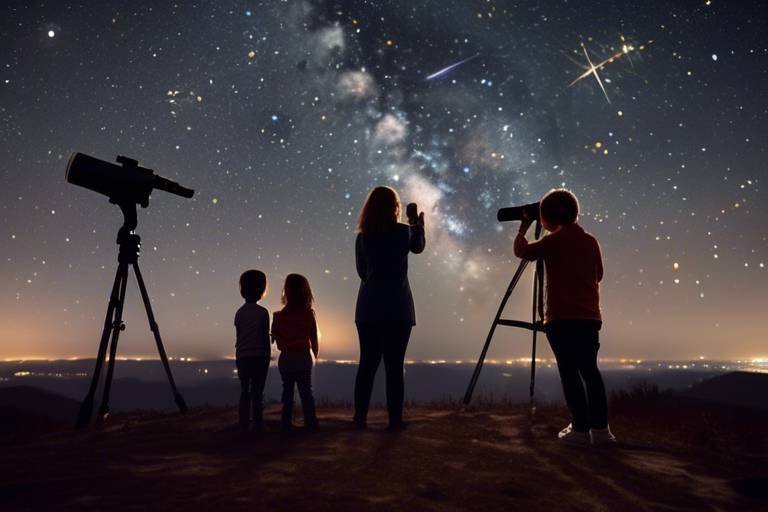Stargazing Locations for Family Nights Out
Are you ready to embark on a magical journey through the cosmos with your family? Stargazing is not just about looking at the stars; it's about creating unforgettable memories, bonding with your loved ones, and igniting a sense of wonder about the universe. Imagine lying on a blanket, gazing up at a sky sprinkled with countless stars, and sharing stories about constellations and distant galaxies. This article explores the best places for family-friendly stargazing adventures, offering breathtaking views of the night sky, educational experiences, and unforgettable memories under the stars.
National parks are the crown jewels of stargazing locations. With their vast, unpolluted skies, these parks provide some of the darkest environments, making them ideal for observing celestial wonders. Families can enjoy stunning views of the Milky Way while exploring the great outdoors. Many national parks also offer ranger-led astronomy programs, where families can learn about the stars, planets, and other celestial phenomena from knowledgeable guides. Imagine the thrill of spotting a shooting star or identifying a new constellation with your kids – it’s an experience that can spark a lifelong passion for astronomy!
Visiting local observatories can be a fantastic way to engage with astronomy experts and get a closer look at celestial bodies through powerful telescopes. Many observatories offer educational programs specifically designed for children, making it a perfect outing for families. Picture your child’s eyes lighting up as they gaze through a telescope and see the rings of Saturn for the first time! These experiences not only educate but also inspire curiosity about the universe. Plus, you might even get a chance to attend special lectures or workshops that make the night even more memorable.
Planetariums offer immersive experiences that are both educational and entertaining. Families can enjoy shows that delve into the mysteries of the universe, from the birth of stars to the exploration of distant galaxies. These captivating environments make learning about constellations, planets, and astronomical phenomena feel like an adventure. Imagine sitting in a darkened dome, surrounded by the wonders of the universe, while a knowledgeable narrator guides you through the cosmos. It’s a fantastic way to bond as a family while expanding your understanding of the night sky.
Many planetariums boast interactive exhibits that encourage hands-on learning. Children can explore various space-related topics through fun activities and experiments, enhancing their understanding of the universe. These exhibits often include simulations, models, and games that make learning about space feel like play. It’s like stepping into a science fiction movie where you can touch and interact with the cosmos!
Planetariums frequently host special events, such as star parties, where families can gather to observe the night sky together. These events foster community engagement and provide unique stargazing opportunities. Imagine mingling with fellow stargazers, sharing tips, and marveling at the beauty of the stars as a community. These gatherings are not only educational but also create a sense of belonging and excitement.
In this digital age, stargazing apps can significantly enhance family outings by helping you identify stars, planets, and constellations. These user-friendly tools make it easier for families to connect with the night sky and learn together. Just point your smartphone at the sky, and voila! You can discover what celestial objects are twinkling above you. It’s like having a personal astronomy guide right in your pocket! Plus, these apps often include fun facts and challenges that can turn your stargazing night into an exciting adventure.
If you're looking to escape the hustle and bustle of city life, heading to rural areas can reveal breathtaking starry skies that will leave you in awe. Away from the bright lights, families can enjoy camping trips or nighttime picnics while marveling at the beauty of the Milky Way. Picture this: you and your family sitting around a campfire, sharing stories, and then looking up to see a dazzling display of stars stretching across the sky. It’s the perfect backdrop for creating lasting memories and fostering a love for nature and the universe.
When stargazing in rural areas, safety should always be a priority. Here are some simple tips to ensure a safe and enjoyable experience:
- Bring flashlights to navigate your surroundings.
- Stay on marked paths to avoid getting lost.
- Be aware of wildlife and keep a safe distance.
By following these guidelines, you can focus on enjoying the beauty of the night sky without any worries!
Having the right gear can elevate your stargazing experience. Here are some essentials to consider bringing along:
- Blankets: For comfort while lying on the ground.
- Binoculars: To get a closer look at celestial objects.
- Star charts: To help identify constellations and planets.
With the right gear, your family can fully immerse yourselves in the wonders of the cosmos, making your night under the stars even more enjoyable.
Q: What is the best time of year for stargazing?
A: The best time for stargazing is typically during the fall and winter months when the skies are clearer and the nights are longer.
Q: Do I need a telescope for stargazing?
A: While telescopes can enhance your experience, they are not necessary. Many celestial objects can be seen with the naked eye or with binoculars.
Q: How can I find a good stargazing location?
A: Look for areas away from city lights, such as national parks, rural areas, or dedicated observatories. Online resources and apps can also help you find nearby locations.
Q: What should I do if I see a shooting star?
A: Make a wish! Traditionally, people believe that when you see a shooting star, you should close your eyes and make a wish before it disappears.

[National Parks]
When it comes to stargazing, national parks are the hidden gems that every family should consider. Imagine stepping into a vast wilderness where the only light pollution comes from the twinkling stars above. National parks offer some of the darkest skies, making them ideal for observing celestial wonders. Families can enjoy breathtaking views of the night sky while immersing themselves in the beauty of nature. It's an experience that feels almost magical, like stepping into a storybook where the characters are constellations and planets.
Many national parks not only provide stunning views but also host ranger-led astronomy programs. These programs are designed to educate visitors about the night sky, helping families connect with the universe in a meaningful way. Imagine gathering around a campfire, sharing stories, and then, under the guidance of an expert, pointing out constellations that have been admired for centuries. It’s a fantastic way to bond as a family while learning about the cosmos.
Here are some of the top national parks known for their stellar stargazing opportunities:
| National Park | Location | Notable Features |
|---|---|---|
| Yosemite National Park | California | Iconic granite cliffs and dark skies |
| Big Bend National Park | Texas | One of the least light-polluted areas in the U.S. |
| Grand Canyon National Park | Arizona | Stunning vistas and astronomy programs |
| Joshua Tree National Park | California | Unique rock formations and clear night skies |
Each of these parks offers something unique, whether it's the rugged beauty of the Grand Canyon or the otherworldly landscapes of Joshua Tree. No matter where you go, the experience of lying on a blanket, gazing up at the Milky Way, is something that will stay with you forever. It's more than just a family outing; it's an opportunity to create unforgettable memories that will be cherished for years to come.
So, pack your bags, grab a telescope or some binoculars, and prepare for an adventure that will light up your family's nights. With the right preparation and a sense of wonder, your family can explore the cosmos together, making every stargazing trip a new chapter in your family story.

[Local Observatories]
Visiting local observatories can be an exhilarating experience for families looking to delve deeper into the wonders of the universe. These venues are not just buildings filled with telescopes; they are gateways to the cosmos, offering families the chance to engage with astronomy experts who are passionate about sharing their knowledge. Imagine standing under a vast expanse of stars, guided by someone who can explain the intricacies of each constellation and the stories behind them. It’s like having a personal tour guide in the universe!
Many observatories provide educational programs specifically designed for children. These programs often include hands-on activities that make learning about space fun and interactive. For instance, kids might get the chance to use telescopes to observe planets or learn about the life cycle of stars. This direct engagement not only enhances their understanding but also ignites a sense of wonder about the universe. It’s an opportunity to transform a simple family outing into an educational adventure that can spark a lifelong interest in science and astronomy.
Additionally, local observatories frequently host special events such as star parties where families can gather to observe celestial events. These gatherings often coincide with significant astronomical occurrences like meteor showers or planetary alignments, creating a magical atmosphere under the night sky. Picture this: families sprawled on blankets, sharing snacks, and looking through telescopes while marveling at the beauty of the cosmos. It’s a perfect blend of learning and leisure, making it an unforgettable experience.
One of the best things about local observatories is that they often cater to all ages, ensuring that everyone from toddlers to grandparents can enjoy the experience. Many observatories have interactive exhibits that allow visitors to explore space-related topics at their own pace. These exhibits can range from simulations of space missions to hands-on experiments that demonstrate the principles of astronomy. It’s like stepping into a science fiction movie, where the wonders of the universe are at your fingertips!
In summary, local observatories are a treasure trove of knowledge and adventure for families. They provide a unique blend of education and fun, ensuring that everyone leaves with a greater appreciation for the universe. So, the next time you’re planning a family outing, consider visiting a local observatory. It’s not just about looking at stars; it’s about creating lasting memories together as you explore the cosmos!
- What should we bring to a local observatory? It's best to bring warm clothing, snacks, and any personal telescopes if you have one. Also, consider a notebook for jotting down observations!
- Are local observatories suitable for young children? Absolutely! Many observatories have programs and exhibits specifically designed for younger audiences.
- Do we need to book in advance? While some observatories allow walk-ins, it's recommended to check their website for any special events or to book tickets in advance to avoid disappointment.

[Planetarium Shows]
Visiting a planetarium can be one of the most exciting and educational experiences for families looking to explore the wonders of the universe. Imagine sitting in a darkened dome, surrounded by the twinkling stars and swirling galaxies, while a knowledgeable presenter guides you through the mysteries of the cosmos. Planetarium shows are designed to captivate audiences of all ages, making them an ideal outing for families. Each show typically combines stunning visuals with informative narration, allowing families to learn about everything from constellations and planets to the latest discoveries in astronomy.
Many planetariums offer a variety of shows that cater to different interests and age groups. Some might focus on the mythology behind the constellations, while others dive deep into the science of black holes or the formation of stars. Families can often choose from a schedule of shows, each lasting around 30 to 60 minutes, ensuring there's something for everyone. Not only do these shows entertain, but they also spark curiosity and inspire future astronomers. For instance, children might leave a show buzzing with questions about how stars are born or what lies beyond our solar system.
Moreover, planetarium shows are often enhanced by state-of-the-art technology. Many modern planetariums utilize high-definition projectors and surround sound systems to create an immersive experience that feels almost otherworldly. This technology allows families to feel as though they are truly traveling through space, making the learning experience even more impactful. The combination of visual effects and engaging storytelling can turn a simple outing into an unforgettable adventure.
In addition to regular shows, many planetariums host special events that can further enrich the experience. These events may include guest speakers, themed nights, or workshops that allow families to engage more deeply with the subject matter. For instance, a family might attend a special event focused on the upcoming meteor shower, learning not just about the phenomenon but also about the best practices for viewing it. This kind of engagement fosters a sense of community and shared excitement among participants.
To help families maximize their visit, many planetariums also provide supplementary materials, such as brochures or online resources, where they can learn more about the topics covered in the shows. This additional information can be a great way for families to continue their exploration of the universe long after they leave the planetarium. Whether it's through reading up on the latest astronomical research or planning a stargazing night at home, the possibilities for learning are endless.
In conclusion, planetarium shows are a fantastic way for families to bond over a shared love of the cosmos. With engaging presentations, cutting-edge technology, and a plethora of educational opportunities, a visit to the planetarium is sure to leave families with lasting memories and a deeper understanding of the universe. So, next time you're looking for a fun and educational outing, consider heading to your local planetarium!
- What age group is suitable for planetarium shows? Most planetarium shows are designed for a wide range of ages, but it's always good to check the specific show’s recommendations.
- How long do planetarium shows typically last? Shows usually last between 30 to 60 minutes, depending on the topic and format.
- Are there any interactive elements in planetarium shows? Many planetariums include interactive segments or Q&A sessions to engage the audience further.
- Can we book private shows for special occasions? Some planetariums offer private bookings for events like birthday parties or school field trips. It's best to contact them directly for details.

[Interactive Exhibits]
When it comes to exploring the cosmos, nothing beats the thrill of interactive exhibits at planetariums. These hands-on experiences are designed not just to inform but to captivate the imagination of visitors of all ages. Imagine your child’s eyes lighting up as they manipulate a digital model of the solar system, watching planets orbit in real-time. These exhibits transform complex astronomical concepts into engaging activities that make learning fun!
Many planetariums feature a variety of interactive displays, from virtual reality experiences that allow you to "walk" on Mars to touch-screen interfaces where you can explore the phases of the moon. Each exhibit is crafted to foster curiosity and encourage questions, making it a perfect family outing. You might find yourself pondering, “How far is the nearest star?” or “What would it be like to live on another planet?” These questions spark discussions that can last long after you leave the planetarium.
Additionally, some interactive exhibits focus on local astronomy, such as the night sky visible from your hometown. This personalized touch can help families connect with the universe in a more profound way. For example, you might encounter an exhibit that shows the constellations visible in your area during different seasons, complete with stories and myths associated with them. This not only enhances your stargazing knowledge but also enriches your family’s shared experience under the stars.
To give you a better idea of what to expect, here’s a quick overview of common types of interactive exhibits you might find:
| Exhibit Type | Description |
|---|---|
| Virtual Reality Experiences | Explore distant planets and galaxies as if you were really there. |
| Touch-Screen Interfaces | Engage with various astronomical phenomena through interactive displays. |
| Augmented Reality Apps | Use your smartphone to see constellations and celestial bodies in real-time. |
| Hands-On Activities | Participate in experiments that demonstrate concepts like gravity and light. |
These interactive experiences not only serve to educate but also to inspire. They encourage families to ask questions and explore the universe together. So, the next time you plan a visit to a planetarium, be sure to dive into these interactive exhibits. They are the perfect way to ignite a passion for astronomy in both young and old alike!
Q: How can interactive exhibits enhance my child's learning experience?
A: Interactive exhibits engage children through hands-on activities, making complex subjects like astronomy fun and relatable. This approach encourages curiosity and fosters a deeper understanding of the universe.
Q: Are interactive exhibits suitable for all ages?
A: Yes! Most interactive exhibits are designed to be accessible and enjoyable for visitors of all ages, making them perfect for family outings.
Q: Do I need to make reservations to visit a planetarium with interactive exhibits?
A: It’s best to check with your local planetarium regarding reservations. Some may require tickets in advance, especially during special events or weekends.

[Special Events]
Special events at planetariums are like the cherry on top of a delicious sundae—they take your stargazing experience to a whole new level! These gatherings, often dubbed "star parties," create a vibrant atmosphere where families can come together to appreciate the wonders of the night sky. Imagine setting up your blanket under a vast expanse of twinkling stars, surrounded by fellow stargazers, all eager to share in the excitement of discovering constellations and planets. It's an experience that fosters both community and curiosity, making it perfect for families looking to bond under the celestial canvas.
What makes these events particularly captivating is the unique programming that often accompanies them. Many planetariums invite local astronomers and educators to lead discussions, share fascinating stories about the cosmos, and provide insights into the latest astronomical discoveries. Not only do families get to observe the stars through powerful telescopes, but they also gain a deeper understanding of what they’re looking at. It’s like having a personal tour guide for the universe!
Additionally, some special events feature themed nights, where the focus might be on specific celestial phenomena, such as meteor showers or lunar eclipses. During these nights, families can participate in activities designed to enhance their experience. For instance, they might enjoy:
- Hands-on workshops that teach them how to use telescopes effectively.
- Interactive presentations that delve into the science behind the stars.
- Craft stations for kids to create their own constellations.
These engaging activities not only make learning fun but also ignite a passion for astronomy in young minds. After all, what could be more thrilling than identifying a shooting star or spotting a planet like Jupiter with your own eyes? Special events at planetariums transform stargazing from a quiet activity into a lively, educational adventure that the whole family can enjoy together.
Q: What should we bring to a special event at a planetarium?
A: It's a good idea to bring a blanket or chairs for seating, snacks for a picnic feel, and perhaps a notebook to jot down interesting facts you learn during the event.
Q: Are these events suitable for young children?
A: Absolutely! Many planetariums tailor their programs to be family-friendly, ensuring that there are engaging activities for kids of all ages.
Q: Do we need to register in advance for special events?
A: While some events may require registration due to limited space, many are open to walk-ins. It’s best to check the planetarium’s website for specific details about the event you’re interested in.

[Stargazing Apps]
In this digital age, stargazing apps have become essential tools for families looking to explore the night sky. These apps are like having a personal astronomy guide right in your pocket, making it easier than ever to identify stars, planets, and constellations. Imagine lying on a blanket under a vast sky, and with just a few taps on your smartphone, you can point to a shining star and instantly learn its name and distance from Earth. Isn’t that amazing?
Many stargazing apps are designed with user-friendliness in mind, allowing both kids and adults to engage with the cosmos. For instance, some apps use augmented reality (AR) to overlay information about celestial bodies on your screen as you hold up your device to the sky. This interactive experience not only captivates children but also encourages them to ask questions and delve deeper into the mysteries of the universe.
Here are some popular features that many stargazing apps offer:
- Real-time Sky Mapping: Point your device at the sky, and the app will display the names of stars, planets, and constellations in real-time.
- Night Mode: This feature reduces screen brightness to preserve your night vision, allowing you to fully enjoy the starlit sky.
- Educational Content: Many apps provide detailed descriptions of celestial objects, helping families learn about the universe together.
When choosing a stargazing app, consider factors such as user reviews, compatibility with your device, and whether it includes the features that best suit your family's needs. Some apps even offer a community feature, where you can connect with other stargazers, share your experiences, and participate in challenges. This adds a social element to your stargazing adventures, making it even more enjoyable.
In conclusion, incorporating stargazing apps into your family nights out can transform a simple evening into an educational and awe-inspiring experience. Whether you're seasoned astronomers or first-time stargazers, these apps bridge the gap between curiosity and knowledge, making the universe feel a little closer and a lot more exciting.
1. What are the best stargazing apps for beginners?
Some of the best apps for beginners include SkyView, Star Walk 2, and SkySafari. These apps are user-friendly and provide excellent educational resources.
2. Do stargazing apps work without an internet connection?
Yes, most stargazing apps can function offline once they have been downloaded. However, some features may require an internet connection for updates or additional content.
3. Are there stargazing apps suitable for children?
Absolutely! Many stargazing apps are designed specifically for kids, featuring fun graphics and interactive elements that make learning about the night sky enjoyable.
4. Can I use stargazing apps during the day?
While stargazing apps are primarily designed for nighttime use, some apps offer daytime features that allow users to identify celestial bodies visible during the day, such as the sun and the moon.

[Rural Areas]
When it comes to stargazing, rural areas are like hidden gems waiting to be discovered. Imagine escaping the hustle and bustle of city life, where bright lights drown out the wonders of the night sky. In rural areas, the darkness envelops you, revealing a breathtaking tapestry of stars that simply can't be seen in urban environments. Families can embark on unforgettable adventures, whether it's camping under the stars or enjoying a cozy nighttime picnic, all while marveling at the beauty of the Milky Way.
One of the best parts about rural stargazing is the sheer tranquility it offers. The air is crisp, the sounds of nature surround you, and the only thing above is a vast canvas of stars. This serene environment not only enhances your stargazing experience but also provides an excellent opportunity for families to bond. Picture this: you lay back on a blanket, looking up at the constellations, while sharing stories and laughter. It's a chance to connect with each other and the universe in a way that’s both magical and educational.
To make the most of your rural stargazing adventure, consider the following essential tips:
- Choose the Right Location: Look for places far away from city lights. Parks, campgrounds, or even family-owned farms can be perfect spots.
- Timing is Everything: The best stargazing usually happens on clear nights, away from the moon's brightness. Check the lunar calendar before heading out!
- Pack Smart: Bring along blankets, snacks, and perhaps a telescope or binoculars to enhance your view.
Additionally, many rural areas offer organized stargazing events where families can join local astronomy clubs. These events often feature knowledgeable guides who can point out constellations and share fascinating stories about the night sky. It's like having your own personal tour of the universe!
However, while enjoying the beauty of rural stargazing, safety should always be a priority. Here are some quick safety tips:
- Bring Flashlights: A good flashlight is essential for navigating at night, but consider using red light to preserve your night vision.
- Stay on Marked Paths: To avoid any accidents, stick to trails and avoid wandering off into the dark.
- Be Aware of Wildlife: Always keep an eye out for local wildlife, especially if you're in a remote area.
In summary, rural stargazing is a fantastic way for families to explore the wonders of the universe together. The combination of dark skies, beautiful landscapes, and the joy of shared experiences makes it an unforgettable adventure. So, pack your gear, head out to a rural area, and prepare to be amazed by the dazzling display of stars that awaits you!
Q: What is the best time of year for stargazing in rural areas?
A: The best time for stargazing is during the fall and winter months when the skies are often clearer. However, any clear night can provide a stunning view!
Q: Do I need special equipment for stargazing?
A: While you can enjoy stargazing with just your eyes, binoculars or a telescope can enhance your experience. Star charts or stargazing apps can also help identify celestial objects.
Q: Are there any safety concerns when stargazing in rural areas?
A: Yes, it's important to stay on marked paths, be aware of wildlife, and bring a flashlight for navigation. Always prioritize safety while enjoying your adventure.

[Safety Tips]
Explore the best places for family-friendly stargazing adventures, offering breathtaking views of the night sky, educational experiences, and unforgettable memories under the stars.
National parks provide some of the darkest skies, making them ideal for stargazing. Families can enjoy stunning celestial views while exploring nature and participating in ranger-led astronomy programs.
Visiting local observatories allows families to engage with astronomy experts and use telescopes for a closer look at celestial bodies. Many observatories offer educational programs tailored for children.
Planetariums offer immersive experiences with shows that educate and entertain. Families can learn about constellations, planets, and other astronomical phenomena in a captivating environment.
Many planetariums feature interactive exhibits that encourage hands-on learning. Children can explore space-related topics through fun activities and experiments that enhance their understanding of the universe.
Planetariums often host special events like star parties, where families can gather to observe the night sky together. These events foster community engagement and provide unique stargazing opportunities.
Stargazing apps can enhance family outings by helping identify stars, planets, and constellations. These tools make it easier for families to connect with the night sky and learn together.
Escaping to rural areas away from city lights can reveal breathtaking starry skies. Families can enjoy camping trips or nighttime picnics while marveling at the beauty of the Milky Way.
When venturing out for a stargazing adventure, safety should be a top priority. The allure of the night sky can be mesmerizing, but it's essential to prepare adequately to ensure a fun and secure experience. First and foremost, bring a flashlight—preferably one with a red filter to preserve your night vision. This way, you won't trip over any hidden obstacles while navigating your chosen stargazing spot. It's also wise to stay on marked paths to avoid any unexpected encounters with wildlife, which can be more active at night.
Additionally, consider the following safety tips:
- Stay Hydrated: Bring plenty of water, especially if you're hiking to your stargazing location.
- Dress Appropriately: Temperatures can drop significantly at night, so layering is key to staying warm.
- Inform Someone: Always let someone know where you’re going and when you plan to return.
Lastly, keep a first-aid kit handy. Accidents can happen, and being prepared can make all the difference. With these precautions in place, families can fully immerse themselves in the beauty of the night sky while ensuring everyone's safety.
Having the right gear can elevate the stargazing experience. Families should consider bringing blankets, binoculars, and star charts to enhance their night under the stars.
Q: What are the best times of year for stargazing?
A: Generally, late spring to early fall offers the clearest skies and milder temperatures, making it ideal for stargazing.
Q: Do I need a telescope to enjoy stargazing?
A: While telescopes can enhance your experience, many celestial objects are visible to the naked eye, especially with the right stargazing apps.
Q: How can I find local stargazing events?
A: Check local observatories, planetariums, and community centers for upcoming events. Websites and social media pages often provide the latest information.
Q: Is stargazing safe for children?
A: Yes, stargazing can be a safe and educational activity for children when proper precautions are taken, such as staying on trails and being aware of surroundings.

[Essential Gear]
When it comes to stargazing, having the right gear can make all the difference between a mediocre night and an unforgettable adventure under the stars. Imagine lying back on a soft blanket, surrounded by your loved ones, as you gaze up at a sky filled with twinkling stars. To enhance this magical experience, consider packing some essential items that will not only keep you comfortable but also help you explore the universe more effectively.
First and foremost, a sturdy blanket is a must. It provides a cozy spot to sit or lie down while you take in the celestial wonders above. Opt for a large, waterproof blanket that can accommodate the whole family. This way, everyone can comfortably enjoy the show without worrying about damp grass or chilly ground.
Next, binoculars can be a game-changer. While telescopes are often associated with serious stargazing, binoculars are portable and user-friendly, making them perfect for families. They allow you to get a closer look at the moon's craters or the bands on Jupiter, all while being lightweight enough to carry along. Plus, binoculars are a fantastic way to introduce kids to astronomy without overwhelming them with complex equipment.
Another essential item is a star chart or a stargazing app on your smartphone. These tools can help you identify the constellations and planets visible in the night sky. Imagine the excitement on your child's face when they spot Orion's Belt or recognize the Big Dipper for the first time! With a star chart in hand or an app at your fingertips, you can turn a simple night out into an educational experience that sparks curiosity and wonder.
Don’t forget to bring along some snacks and drinks. A little picnic under the stars can elevate your stargazing experience. Think about packing some hot cocoa in a thermos, along with some tasty treats. Sharing these moments with family while gazing at the cosmos creates a delightful atmosphere that everyone will cherish.
Finally, safety should always be a priority. Make sure to bring a flashlight or headlamp, preferably one with a red filter. This will help you navigate in the dark without ruining your night vision. Staying on marked paths and being aware of your surroundings is crucial, especially in rural areas where wildlife may be present.
In summary, the right gear can transform your stargazing experience from ordinary to extraordinary. Whether it’s a cozy blanket, handy binoculars, a star chart, delicious snacks, or a reliable flashlight, each item plays a role in creating unforgettable memories with your family. So gear up, head out, and let the wonders of the universe captivate you!
Q: What is the best time for stargazing?
A: The best time for stargazing is during the new moon phase when the sky is darkest. Also, try to choose a night when the weather is clear and there are minimal clouds.
Q: Do I need a telescope to enjoy stargazing?
A: No, you don't need a telescope! While telescopes can enhance your view, binoculars and the naked eye are often sufficient for spotting many celestial objects.
Q: How can I keep my kids engaged during stargazing?
A: Use star charts or stargazing apps to identify constellations together. You can also tell stories about the stars and planets to keep them entertained.
Q: Is it safe to stargaze in rural areas?
A: Yes, but it's important to take precautions. Stay on marked paths, bring a flashlight, and be aware of your surroundings to ensure a safe experience.
Frequently Asked Questions
- What are the best national parks for stargazing with family?
Some of the best national parks for family stargazing include Yosemite National Park, Grand Canyon National Park, and Big Bend National Park. These parks offer dark skies and organized astronomy programs, making them perfect for a family night out under the stars.
- How can we find local observatories near us?
You can search online using terms like "local observatories near me" or check websites like NASA and the American Astronomical Society for a list of observatories in your area. Many of these places offer family-friendly programs and events.
- Are planetarium shows suitable for young children?
Absolutely! Many planetariums design their shows specifically for children, making learning about space fun and engaging. The immersive experience captures their imagination and often includes interactive elements that keep them entertained.
- What are some recommended stargazing apps for families?
Some great stargazing apps include Star Walk 2, SkyView, and Stellarium. These apps help identify stars, planets, and constellations, making it easier for families to connect with the night sky during their outings.
- What safety tips should we follow while stargazing in rural areas?
When stargazing in rural areas, it's essential to bring flashlights (preferably red ones to preserve night vision), stay on marked paths, and be aware of wildlife. Always inform someone about your plans and stick together as a family for a safe experience.
- What essential gear should we bring for a stargazing trip?
For an enjoyable stargazing experience, consider bringing blankets for comfort, binoculars for closer views, and star charts or apps to help identify celestial objects. Snacks and warm drinks can also enhance the experience!


















